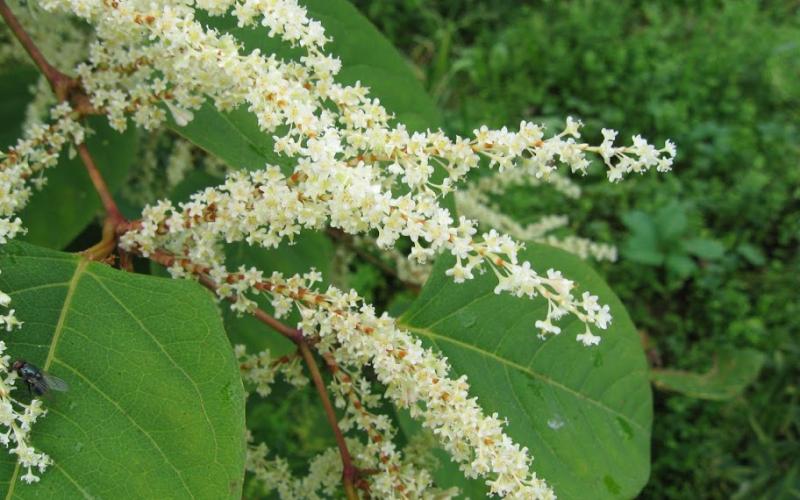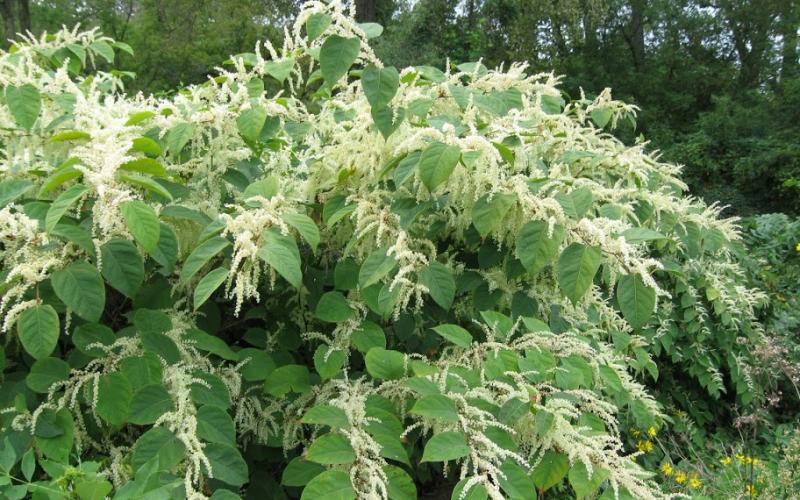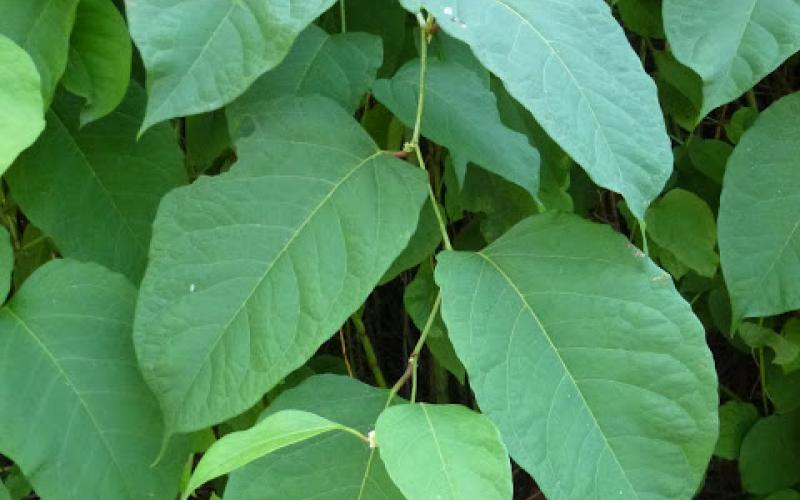Common Name: Japanese Knotweed
Alternate Names: Japanese bamboo, Mexican bamboo, Japanese fleece flower, crimson beauty, Reynoutria, Hancock’s curse
Scientific Names: Polygonum cuspidatum Siebold & Zucc., synonym Fallopia japonica (Houtt.) Ronse Decr.
Related Species: Giant knotweed (Polygonum sachalinense F. Schmidt ex Maxim.); Bohemian knotweed (Polygonum x bohemicum (J. Chrtek & Chrtkova, Zika & Jacobson)
Legal Status
Efforts must be made to prevent seed maturation and dispersal of plants into new areas. Additionally, no transportation, propagation, or sale of these plants is allowed. Failure to comply may result in enforcement action by the county or local municipality.
Background
Japanese knotweed is native to eastern Asia and was imported to England in the mid-1800s as an ornamental. It was prized and planted in many famous gardens. In the late 1800s, it was brought to the United States and was planted in gardens and used for erosion control along roadways and embankments. Japanese knotweed escaped cultivation, overtook desirable vegetation and was recognized as a problem by the early 1900s. Japanese knotweed plants in Europe and North America are known to be clones of a single female plant. Japanese knotweed hybridizes with giant knotweed to form the Bohemian knotweed species.
Description
- Japanese knotweed is a shrub-like, semi-woody perennial growing up to 9 feet tall.
- Leaves are simple, alternate, up to 6 inches long by 4 inches wide, and broadly ovate with pointed tips and a square base.
- Knotweed grows quickly and has hollow, bamboo-like stems that form dense leafy thickets. Stems are green with reddish nodes, become tough and woody with age, and appear reddish-brown in the winter. New shoots emerge in the spring and leaves drop in the fall. Japanese knotweed stems have multiple branches.
- Plants produce flowers in creamy whitish clusters at the upper leaf axils in late August and September and can produce small 3-angled black-brown papery fruit.
- Rhizomes and roots can grow to 6 feet deep and spread outwards to 65 feet, sprouting new shoots at nodes of rhizomes.
- Bohemian knotweed can look very similar (it is a hybrid between Japanese knotweed and giant knotweed) but is generally taller, and has larger leaves with more heart-shaped bases.
- Giant knotweeds also look similar, but plants are much taller and have significantly larger, thinner leaves with heart-shaped bases
Note: There is a dwarf variety of Japanese knotweed (Polygonum cuspidatum var. compacta) also present in Minnesota. Dwarf Japanese knotweed is shorter in height (up to 3 feet) and has smaller, rounder, thicker leaves.
Habitat
Japanese knotweed is often found in sunny areas within intentionally planted landscapes, along roadsides, and in riparian areas such as stream banks. Knotweeds thrive in a range of soil types and light levels although will not be as robust if growing in shady conditions.
Means of spread and distribution
Japanese knotweed can spread both vegetatively and by seed. Rhizomes allow knotweed to spread quickly and aggressively and new colonies can form from very small stem or rhizome fragments. Plant parts can be moved by natural means, such as waterways, and often through human activities such as moving knotweed plant parts to new locations or moving soil contaminated with rhizome fragments. In North America, Japanese knotweed plants produce only female flowers and therefore cannot produce viable seed unless there are giant knotweed or Bohemian knotweeds nearby as pollen source. Japanese knotweed is very persistent after establishment. It is widespread in the eastern US and reported in 43 states. There are many infestations in Minnesota found as landscape plantings and in natural areas. In Minnesota many plants reported as Japanese knotweed have been found to be Bohemian knotweed.
Impact
Japanese knotweed forms tall, dense thickets that shade out and displace native vegetation, degrade habitat for fish and wildlife, can alter waterways, and facilitate erosion and flooding. Knotweed growth through pavement cracks and along paved surface edges can result in damaged pavement.
Prevention and Management
- Do not plant knotweed as an ornamental and eradicate any existing plants from your property. Do not move soil that may contain knotweed rhizome fragments to uninfested areas. A sound management plan is necessary to manage this species and will take a commitment of several years to ensure that the population has been eliminated.
- Foliar and stem injection application of herbicides that translocate their active ingredients into the root system can be very effective. Treatments will need to be repeated for several years to eradicate a population. If using herbicide treatments, check with your local University of Minnesota Extension agent, co-op, or certified landscape care expert for assistance and recommendations. There are several businesses throughout the state with certified herbicide applicators that can be hired to perform chemical applications. Japanese knotweed also grows commonly in riparian and wetland habitats. If treating plants near water with herbicide, please be aware of the state pesticide laws and use only products labeled for aquatic use.
- Do not cut or mow knotweed. Cutting or mowing increases spread and can stimulate growth. Bending stems out of the way can be useful if knotweed blocks pathways.
- Always clean and inspect equipment after working in an infested area to prevent transport of plant fragments and seed to new areas.
- Knotweed lifecycle and treatment timing graphic




